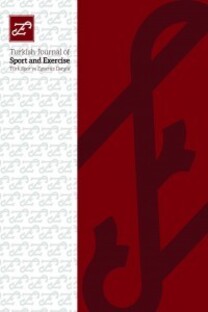Determination of HIF1-Ars11549465 Polymorphism in Elite Skiers
Determination of HIF1-Ars11549465 Polymorphism in Elite Skiers
___
- 1. Ahmetov II, Hakimullina AM, Lyubaeva EV. Vinogradova OL and Rogozkin VA. Effect of HIF1A Gene Polymorphism on Human Muscle Performance. Bulletin of Experimental Biology and Medicine, 2008;146,(3): 327-329,
- 2. Ahmetov II, Williams AG, Popov DV, Lyubaeva EV, Hakimullina AM, Fedotovskaya ON & Rogozkin VA. The combined impact of metabolic gene polymorphisms on elite endurance athlete status and related phenotypes. Hum Genet. 2009;126:751-61.
- 3. Berra E, Benizri E, Ginouves A, Volmat V, Roux D, Pouyssegur J. HIF prolylhydroxylase 2 is the key oxygen sensor setting low steady-state levels of HIF-1α in normoxia. EMBO J, 2003; 22: 4082-4090.
- 4. Bouchard JR, Thomas J, and Matt McGue. "Genetic and environmental influences on human psychological differences." Journal of neurobiology, 2003; 54.1 4-45.
- 5. Çorak A, Kapıcı S, Sercan C, Akkoç O, Ulucan K. A pilot study for determination of anxiety related SLC6A4 promoter "S" and "L" alleles in healthy Turkish athletes. Cellular and Molecular Biology, 2017; 63: 29-31.
- 6. Döring F, Onur S, Fischer A, Boulay MR, Pérusse L, Rankinen T & Bouchard CA. Common haplotype and the Pro582Ser polymorphism of the hypoxia-inducible factor-1α (HIF1A) gene in elite endurance athletes. Journal of Applied Physiology, 2010; (108) 6: 1497-1500.
- 7. Eynon N, Bantingb LK, Ruizc JR, Cieszczykd P, Dyatlove DA, Maciejewska-Karlowskaf A, Sawczukf M, Pushkareve VP, Kulikove LM. ACTN3 R577X polymorphism and teamsport performance: A study involving three European cohorts. Journal of Science and Medicine in Sport, 2014; 17: 102-106.
- 8. Ivan M, Kondo K, Yang H, Kim W, Valiando J, Ohh M, Salic A, Asara JM, Lane WS, Kaelin WG. HIFα targeted for VHLmediated destruction by proline hydroxylation: implications for O2 sensing. Science, 2001; 292: 464-468.
- 9. Kaynar Ö and Bilici MF. Analysis of the Talent Selection in Turkish Wrestling. International Journal of Science Culture and Sport, 2017; 5(4):347-355.
- 10. Korkut Ulucan. Spor Genetiği Açısından Türk Sporcuların ACTN3 R577X Polimorfizm Literatür Özeti. Clin Exp Health Sci 2016; 6(1): 44-47.
- 11. Lysiak JJ, Kirby JL, Tremblay JJ, Woodson RI, Reardon MA, Palmer LA, Turner TT. Hypoxia-inducible factor-1a is constitutively expressed in murine Leydig cells and regulates 3b-hydroxysteroid dehydrogenase type 1 promoter activity. J. Androl, 2009; 2: 146-156.
- 12. Maciejewska A, Sawczuk M, Cieszczyk, P, Mozhayskaya IA, &Ahmetov II. The PPARGC1A gene Gly482Ser in Polish and Russian athletes. Journal of sports sciences, 2012; 30(1): 101- 113.
- 13. Mason SD, Rundqvist H, Papandreou I, Duh R, McNulty WJ, Howlett RA & Johnson RS. HIF-1 in endurance training: suppression of oxidative metabolism. Am J Physiol Regul Integr Comp Physiol,2007; 293: 2059–2069.
- 14. Montgomery HE, Marshall R, Hemingway H. Human gene for physical performance. Nature, 1998; 393(6682): 221–222.
- 15. Prior SJ, Hagberg JM, Phares DA, Brown MD, Fairfull L, Ferrell RE, Roth SM. Sequence variation in hypoxiainducible factor 1 alpha (HIF1A): association with maximal oxygen consumption. Physiol Genomics 2003;15: 20–26.
- 16. Ulucan K, Sercan C, ve Bıyıklı T. Distribution of Angiotensin-1 Converting Enzyme Insertion/Deletion and αActinin-3 Codon 577 Polymorphisms in Turkish Male Soccer Players. Genetics & Epigenetics, 2015: 71-74.
- 17. Yang N, Macarthur DG, Gulbin JP. ACTN3 genotype is associated with human elite athletic performance. American Journal of Human Genetics, 2003;73: 627–631.
- 18. Zilberman-Schapira G, Chen J, Gerstein M. On sports and genes. Recent Patents on DNA & Gene Sequences Journals, 2012; 6: 180-188.
- Yayın Aralığı: 3
- Başlangıç: 1999
- Yayıncı: Selçuk Üniversitesi, Spor Bilimleri Fakültesi
Hani HAJ SALİMİ, Farhad RAHMİNİ-NİA
Selçuk BUĞDAYCI, Uğur ABAKAY, Zeliha ABAKAY
Vedat ÇINAR, Taner AKBULUT, Zarife PANCAR, Yakup KILIÇ
Tülin ATAN, D.özge YÜCELOĞLU KESKİN, İlkay ÇAMLIDAĞ, Deniz Günay DEREBAŞI
Zehra CERTEL, Ziya BAHADIR, Ramazan TOPUZ
Armağan Şahin KAFKAS, Yalçın AYDIN, Özgür EKEN, Fahri Safa ÇINARLI, Muhammed Emin KAFKAS
